 Erin Moran and co-stars have some unhappy days in outer space. 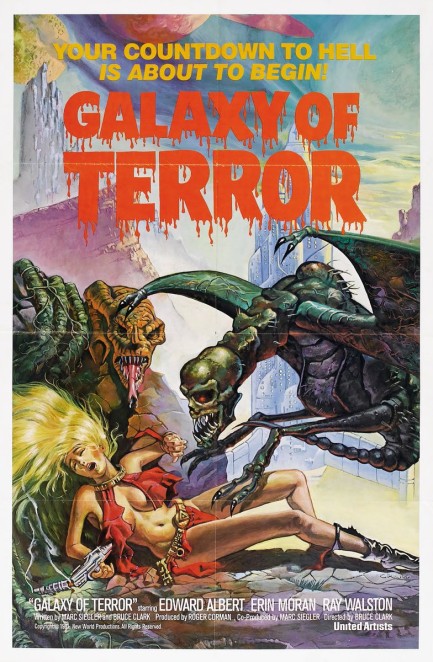
Galaxy of Terror, which premiered in the U.S. today in 1981, was produced by New World Pictures and Roger Corman, and you know what that means—no budget. Corman must have really licked his chops when he heard this pitch. In his genius, he probably realized immediately that he could avoid millions of dollars in costs by making his sets extra cheap and simply bathing them in darkness in order to save on production design. He also went cheap on script, direction, sound, music, special effects, and costuming. The result was one of many terrible outer space movies to hit multiplexes in the wake of Star Wars and Alien. This one is distinct in being influenced by both of those classics while sharing none of their advantages.
The plot deals with an intrepid crew of nine who embark on a military style rescue mission, seeking a ship lost in a distant star system on a planet called Organthus. After various travails, they land on the accursed world, find the lost ship, and make the mistake of entering it. Giant leeches, deadly shuriken, and other horrors bloodily whittle the crew down to an unfortunate few, at which point comes the infamous moment—which may be the only reason Galaxy of Terror is remembered—when poor Taaffe O'Connell is raped and killed by a giant maggot. The mission only goes farther downhill from there as Corman digs deep into the New World prop department for a couple of mothballed monsters to terrorize the survivors.
The thing about science fiction movies back then is that it was impossible to have an inkling of what the end result might be. Basically, the producers said, “Trust us, it'll look good.” The cast of Stars Wars took a leap of faith and were rewarded. The casts of imitator movies hoped to capture the same magic and failed over and over. Galaxy of Terror's budget of five million dollars probably sounded okay, considering Stars Wars cost eleven. The heady desire to roll the dice and hope for the best is probably what enticed co-star Erin Moran into taking a little moonlight ride from her hit television show Happy Days to appear in this turkey. Afterward, she may have considered a lobotomy to help her forget the entire ordeal.
There are, however, a few plusses to Galaxy of Terror. First, young production designer James Cameron probably learned that in sci-fi there's a budgetary floor beneath which disaster is assured, and would later make three of the best and most successful science fiction movies of all time (no, we're not counting Avatar). Second, co-star Zalman King probably realized sci-fi was for suckers, went softcore as a producer and director, and churned out such memorable (and now anachronistic) erotica as Red Shoe Diaries, Two Moon Junction, and Wild Orchid. And third, the poster art by Charo (not the singer) is nice. Also, the movie brought our special consulting critic Angela the Sunbear out of her cave. Watching Galaxy of Terror with her was really fun.
 I think the crew should have stayed in hibernation. I think the crew should have stayed in hibernation.
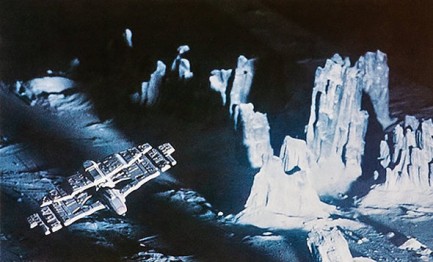 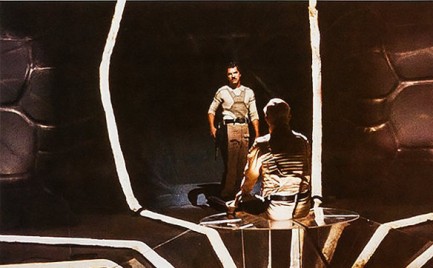 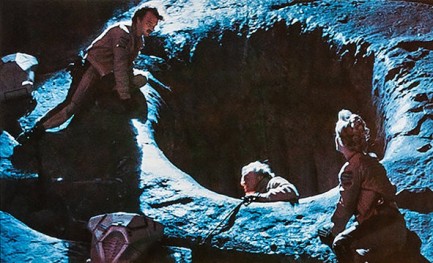 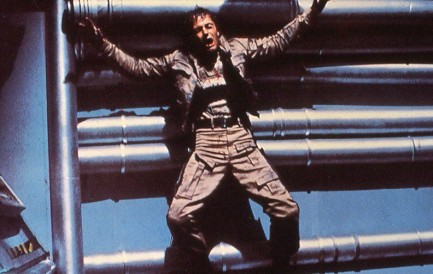 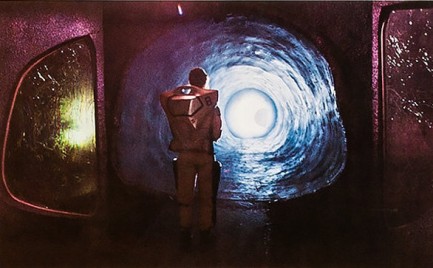  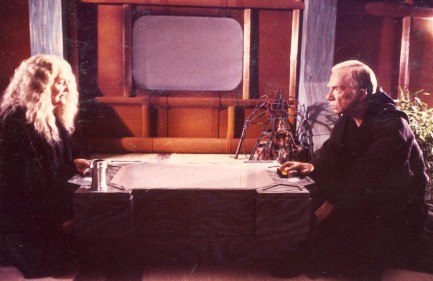 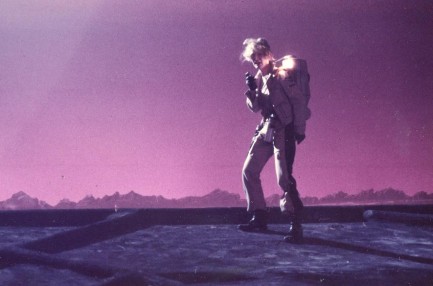 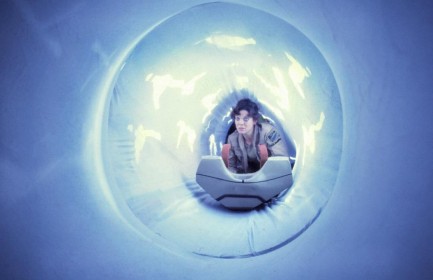 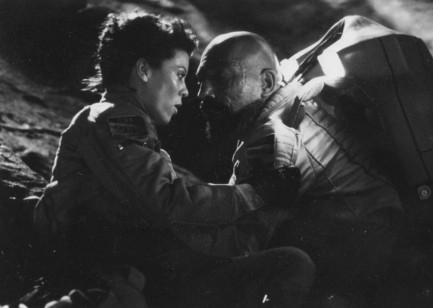 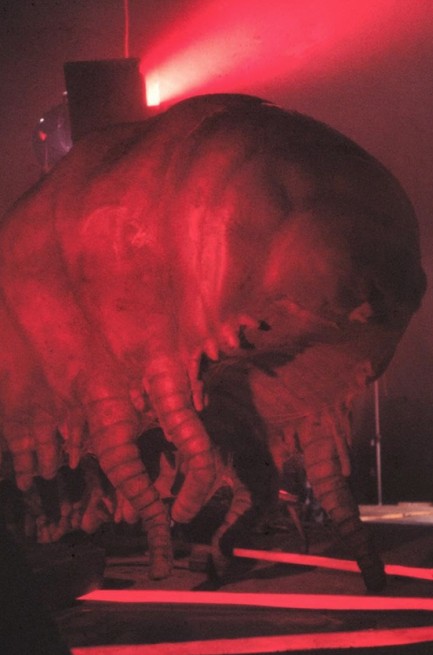 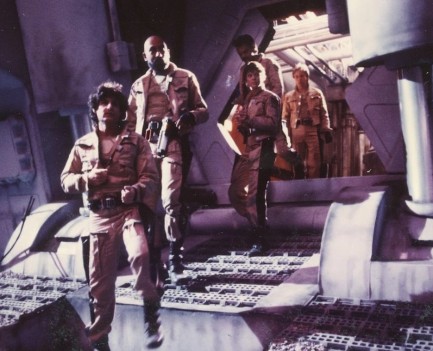 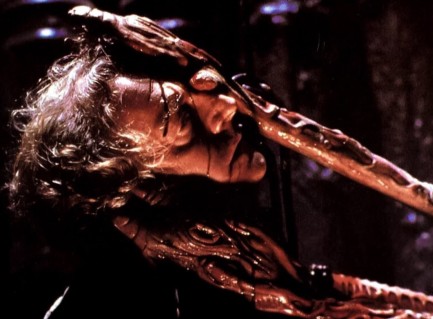 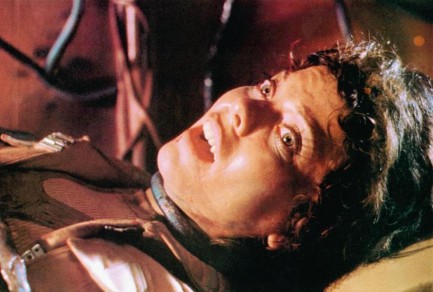
 Steve Sandor draws first blood before Rambo arrives on the scene. 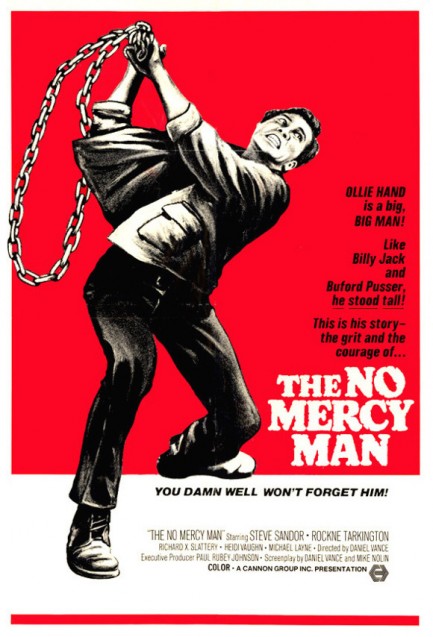
Above you see a low rent poster for The No Mercy Man, aka Bad Man, aka Trained to Kill: USA, which premiered this month in 1973 starring Steve Sandor and Rockne Tarkington, the latter last seen chilling with his pet lion in Black Samson. The No Mercy Man is a mash-up of a biker film, a High Noon-style western, and a blaxploitation film, done on the cheap. And of course with low budgets usually come bad acting, weak scripting, all thumbs in the technical departments, and a paucity of promo images (we found two). This film also has, as a special bonus, a deeply earnest theme song that sucks terribly:
And when he loves you, he loves as hard as he can. You get no mercy, naw naw naw, from the no mercy man. Love and lust are the same to him, just like being raped by the Devil. His kind of love can only bring you sin, and his arms can only bring you evil... whooooa ohhh ohhh...
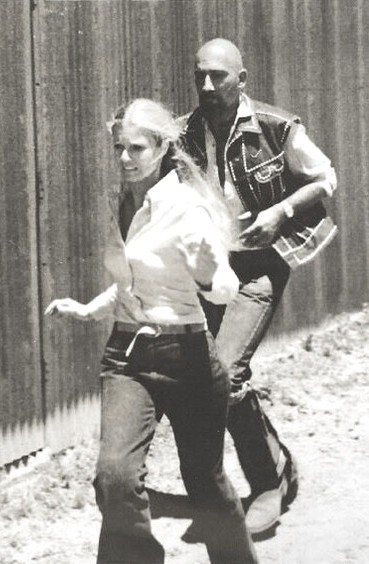 The “no mercy man” of the lyrics is the protagonist Olie Hand, played by Sandor, which means being raped by the Devil is about the hero. Incredibly, the closing theme is even worse, with the lyrics, “no one understands you ’cause you can't be understood.” The “no mercy man” of the lyrics is the protagonist Olie Hand, played by Sandor, which means being raped by the Devil is about the hero. Incredibly, the closing theme is even worse, with the lyrics, “no one understands you ’cause you can't be understood.” Well, let's give it a try. Olie Hand is a Vietnam veteran who did terrible things in the jungles of Southeast Asia, and has now returned to his Arizona hometown to find it plagued by amoral carnies and petty criminals. He's haunted by the war. The sight of violence sends him into a mental tailspin, as horrible memories of his time in action rise to the surface. Despite his aversion to violence, it isn't long before he's forced to take on the men who are turning his town upside down.
Hand is legitimately psychologically damaged, which makes him a clear precursor to Sylvester Stallone's disturbed John Rambo from First Blood. After that film became a runaway hit Stallone booted the mental imbalance of the Rambo character out of the franchise, which freed cinemagoers to revel in hyperviolence without reflection. Rambo became the type of archetypal tough guy many Americans imagine themselves to be—the basically solid guy who tries very hard to avoid trouble, but once he's pushed across the line, boy howdy, you better open wide for your just desserts. Ollie Hand's relationship to John Rambo is clear, but he also brings to mind another iconic movie vigilante.
The year after The No Mercy Man appeared Charles Bronson brought everyman architect Paul Kersey to the screen in Death Wish. Kersey wasn't tortured by previous violent acts; he was justified by current events to commit violence. Killing wasn't harmful but healing, and took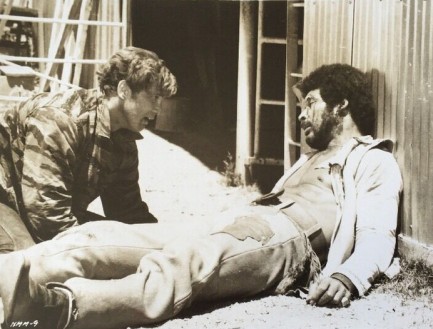 place vigilante style because of the limits of the law. It was done reluctantly, but creatively, because the capacity for baroque forms of murder lurked beneath the surface all along. American action movies have largely resided in that space ever since: violence is a rarely used but well-oiled tool every real man has at the ready, tucked between his pliers and his socket wrench. place vigilante style because of the limits of the law. It was done reluctantly, but creatively, because the capacity for baroque forms of murder lurked beneath the surface all along. American action movies have largely resided in that space ever since: violence is a rarely used but well-oiled tool every real man has at the ready, tucked between his pliers and his socket wrench.
The No Mercy Man is exploitative schlock, but it's at least a bit more thoughtful than the average revenge flick. It suggests there's a price paid for violence beyond mere regret, or being turned into a taciturn curmudgeon whose warm side can eventually be teased out by the right woman or a precocious kid. The price is that you may be so altered that others are unable recognize you as human. If you've actually read your U.S. history—we mean the stuff they only gloss over in school—you know that violence has always been a first resort. The No Mercy Man acknowledges that this isn't ideal, but of course in the end decides pacifism is for pussies. It is, after all, still an American movie.
 In space there are no Happy Days. 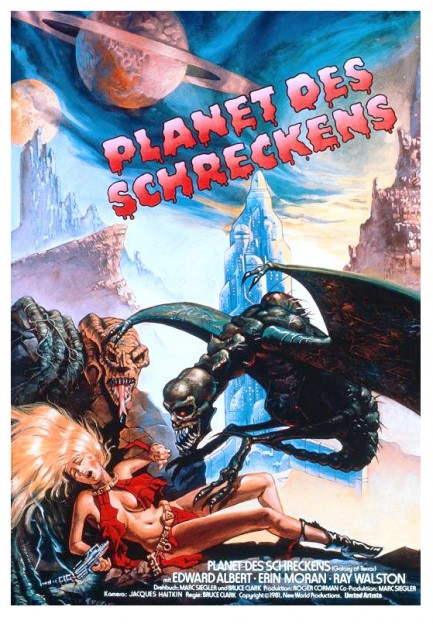
The gap between the quality of a poster and the quality of the film it promotes is often large, but rarely so much as with the infamous sci-fi b-movie Planet des Schreckens, better known as Galaxy of Terror. We're showing you the West German poster because the movie premiered there today in 1982 after originally opening in 1981 in the U.S. The art is signed by Charo, not the hip shaking dancer-singer, but rather someone who we found no further info about online. This is a spectacular comic book style effort and a rarity that costs a hundred dollars or more to acquire. If you've seen the movie you know the art depicts the death of Taaffe O'Connell's character Damela, who falls victim to a giant maggot. Galaxy of Terror boasts b-movie stalwarts Robert Englund and Sid Haig, plus Erin Moran from television's Happy Days, but O'Connell's slippery demise is the reason it's a cult classic. It's no Star Crash, but it's pretty close. We'll circle back and talk about it in detail later.
 Grier goes missing from another foreign poster. 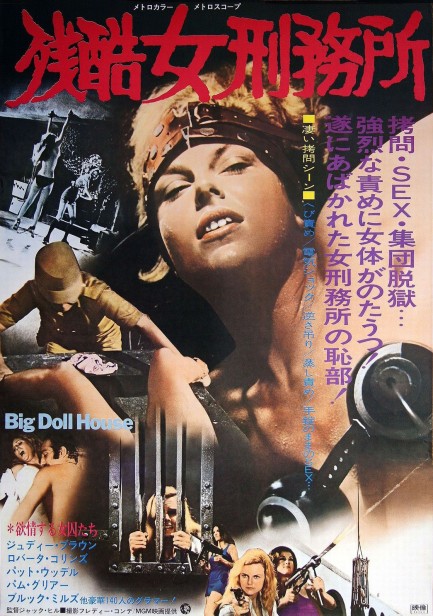
We shared an Italian poster for the 1971 Roberta Collins/Pam Grier women-in-prison flick The Big Doll House, and today we have the Japanese promo. In Japan the movie was called Zankoku Onna-Keimusho, which means something along the lines of “cruel female prison.” Grier doesn't show up on the poster anywhere, though she's third billed. The central figure is Judy Brown, and elsewhere you see Roberta Collins, Sid Haig, and seven other cast members, but no Grier. This is not the only time she was demoted from an overseas poster, and all we can say is it's not a nice thing. The art is still very interesting, though. The Big Doll House opened in Japan today in 1972.
 Treat your toys with care or they might break out. 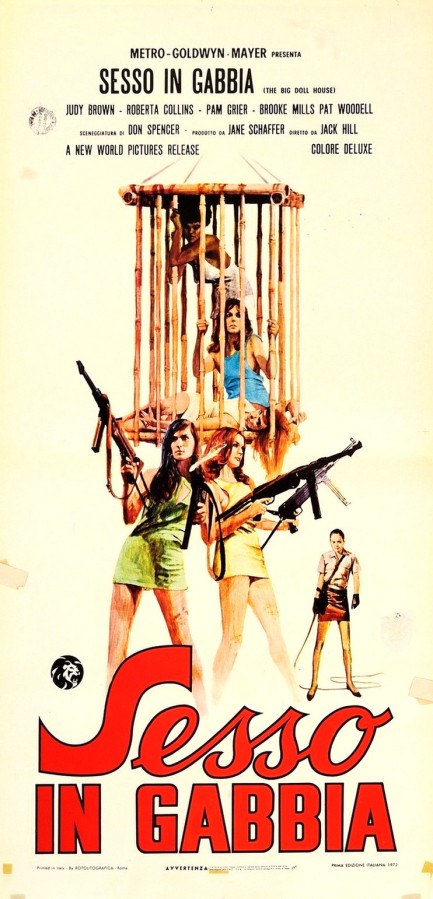
Above is an Italian poster for the American financed, Philippine shot sexploitation actioner The Big Doll House, which starred Roberta Collins, Brooke Mills, Pat Woodell, Pam Grier, and Judy Brown. This wasn't the first women in prison movie—those had been appearing for decades—but it was the one that got the ’70s prison sexploitation ball rolling in the U.S. It offers a full slate of whippings, waterboardings, overheated isolation, and bizarre snake tortures, orchestrated by the evil wardeness Christiane Schmidtmer. Collins leads the beautiful convicts' eventual escape from bondage and hers is the most memorable character in the ensemble, though all the personalities are interesting. Don't get us wrong—the acting is of course atrocious, and the production values aren't high, but that didn't bother us and it didn't bother American audiences either. They made the movie a hit and the women-in-prison conveyor belt quickly cranked out other Filipino bondage productions like Women in Cages, The Hot Box, The Woman Hunt, The Big Bird Cage, and many others. The Big Doll House wasn't the best of the lot, by any stretch, but hey—being a trailblazer matters. We think it's worth a viewing.
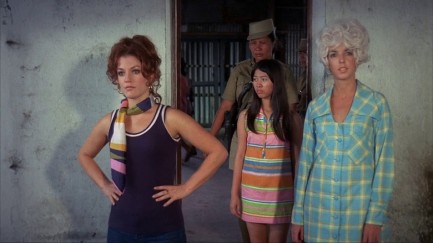 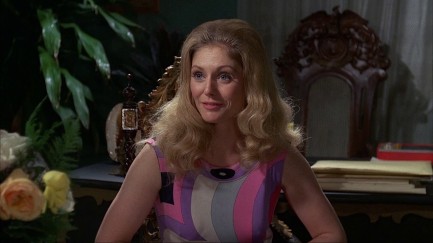 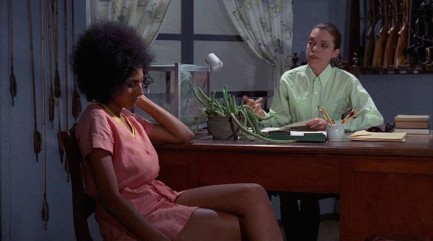 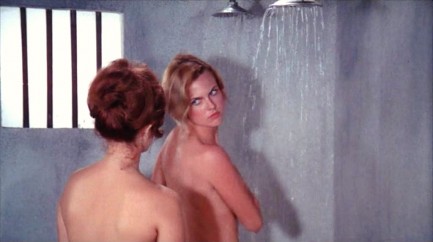 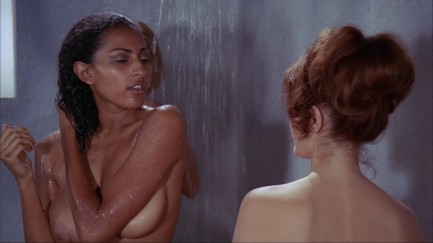 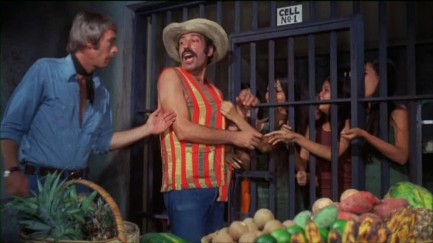 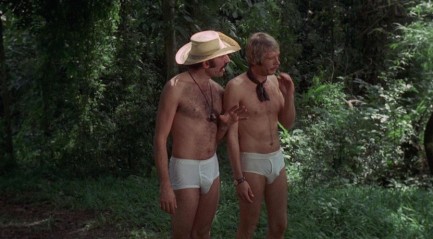 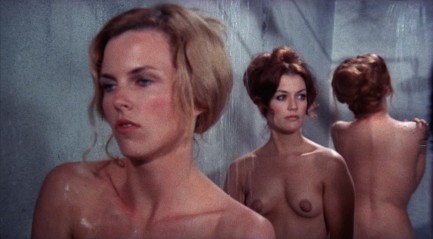 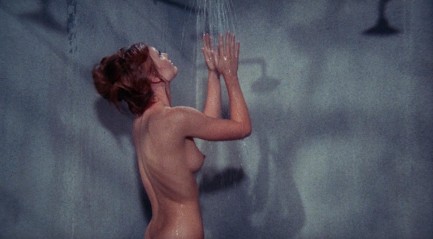 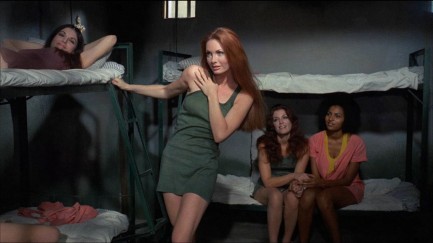
 It's strong and bold and might be just the wake-up you need. 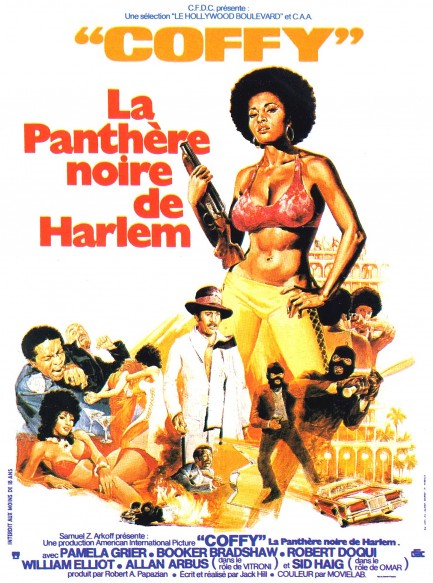
Coffy is not a movie we planned to write about, due to the fact that it's been covered by so many websites. But then we came across this French poster made for its release in Paris today in 1973—where it was called Coffy: la panthère noire de Harlem—and we changed our minds. The movie possibly falls into the category of those everyone has heard about but few have seen, so we gave it a run for the first time in some years. The story is straightforward—a teen girl is in the hospital suffering from the effects of an overdose, and her sister, played by Pam Grier, goes looking for revenge. She kills the dealer who sold heroin to her sis, but soon learns there's another dealer behind that one, and so forth. In a world that's corrupt to the core, revenge is a maze where the center is difficult to find.
Coffy isn't well acted, but those who go in expecting Oscar worthy performances are setting up false standards. Blaxploitation was about telling stories from a new point of view, one lacking in American cinema. Trying to round out a black cast, as well as find compelling black leads, meant taking chances and bringing novice performers into the fold. The message is what mattered in these movies, and the message was that something was seriously wrong in America. Those who paid attention learned one of the most basic lessons anyone can learn—your reality is just one of many. Other people live entirely different lives governed by different, equally valid truths. Mainstream Americans who understood this concept learned plenty from blaxploitation. Those who denied this most simple of life's facts learned nothing—and are the same people who today look at what happens in America's inner cities with bafflement or scathing contempt.
Coffy was really an envelope pushing film. We'll just highlight one scene to make that point. Pam Grier's title character has sex with her boyfriend then heads toward the bathroom. On the way there, but off-camera, we hear her say, “Oops! Oh, you shouldn't have made me laugh.” What do you suppose happened? Here's a hint—it involves spillage, and not from a glass. It may well have been the first movie ever to hint at post-coital drainage. Later it does another off-camera bit with oral sex when Grier pours wine in her boyfriend's lap and proceeds to clean it up. Coffy may not have been well acted, but it had moments of earthy realism that were almost microscopic in focus. You also get plenty of action and a fierce, single-minded heroine you can root for. Coffy opened in France today in 1973. Check out a rare U.S. promo poster for it here.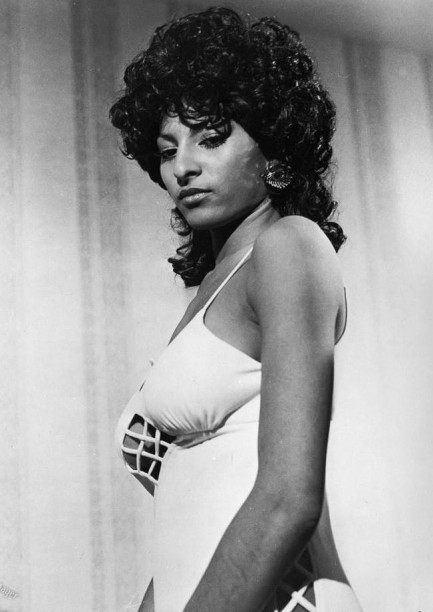 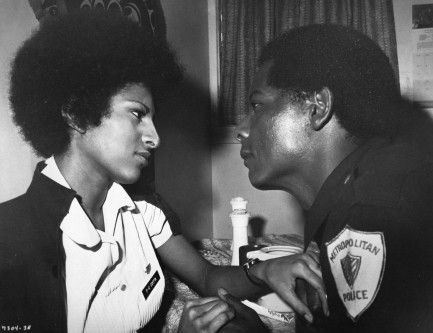 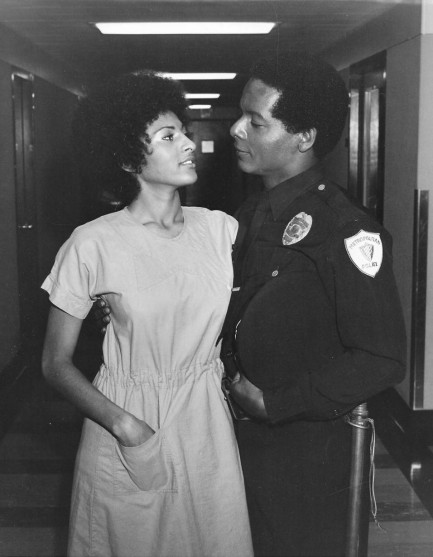 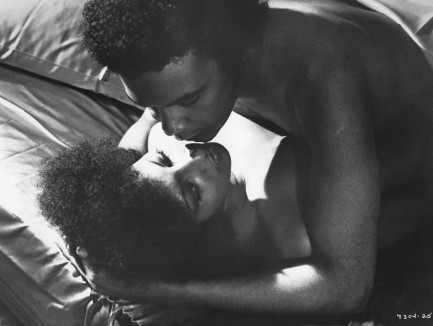 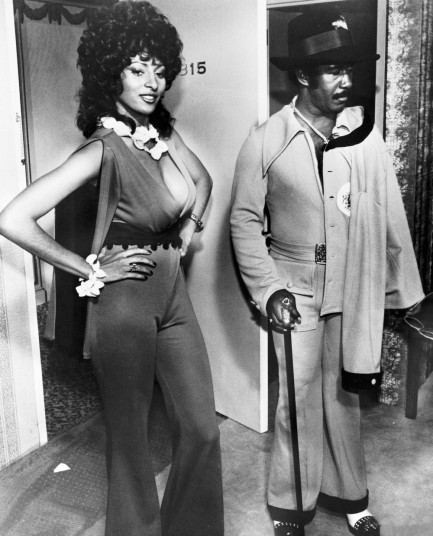 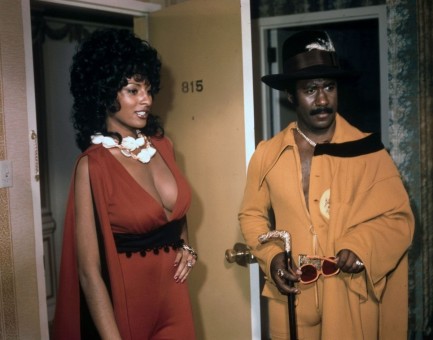 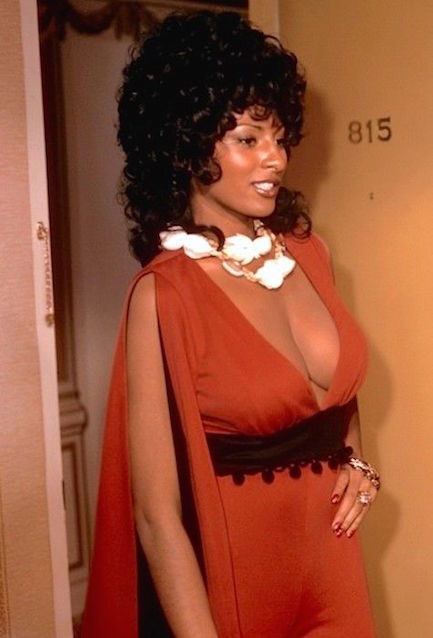 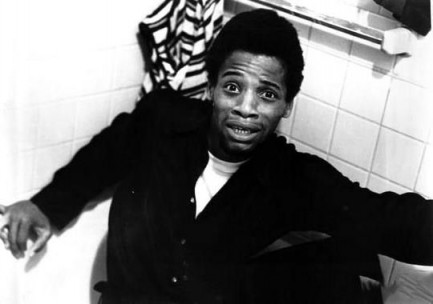 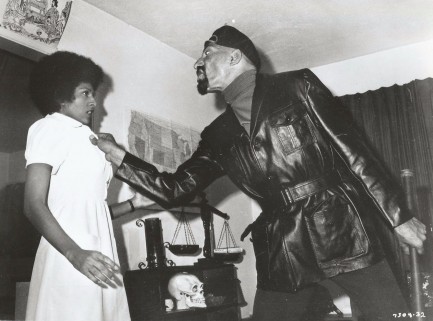 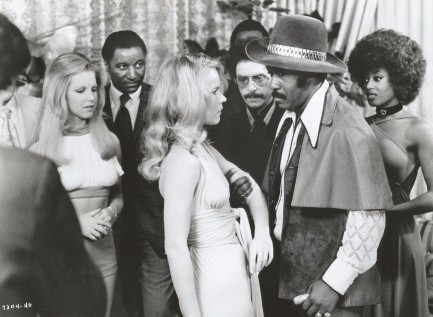 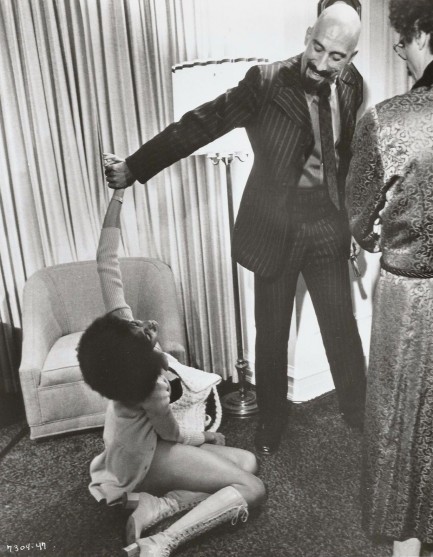 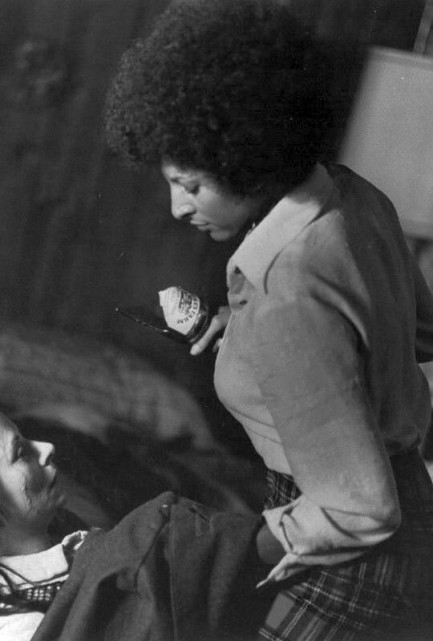 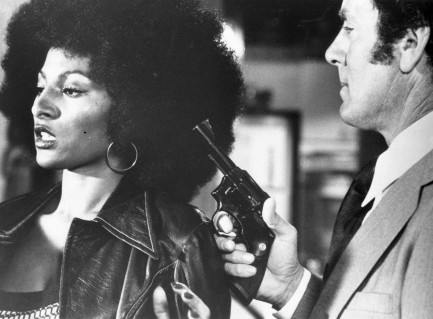 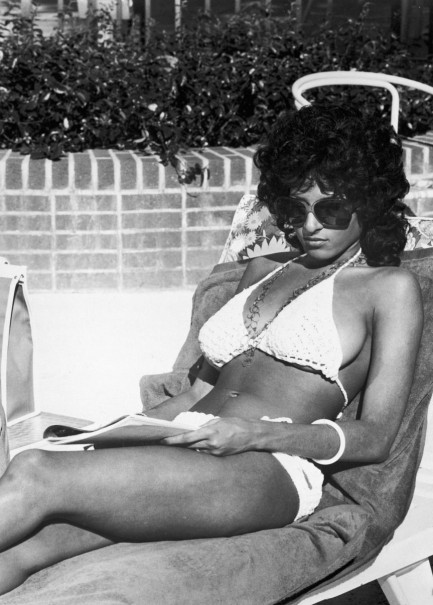 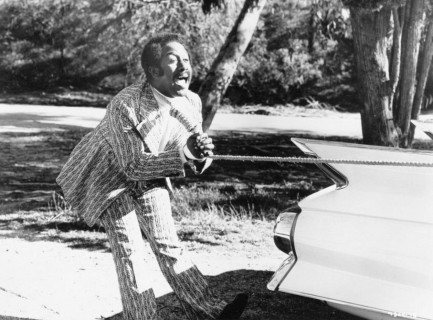 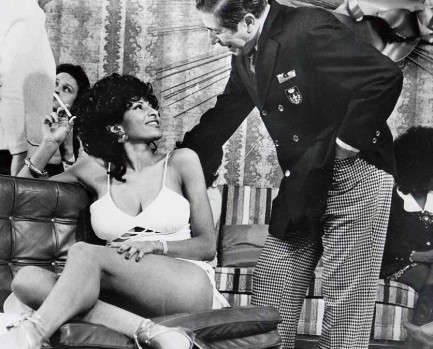 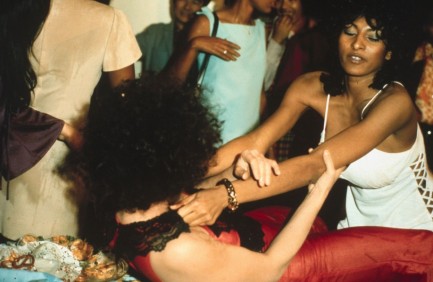 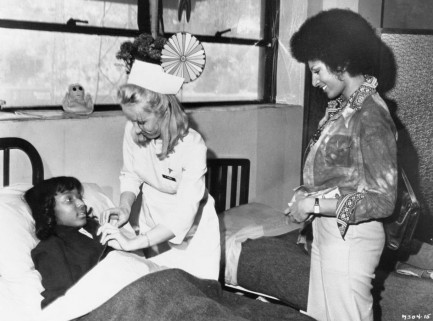
 If you’re looking for mercy you’ve come to the wrong place. 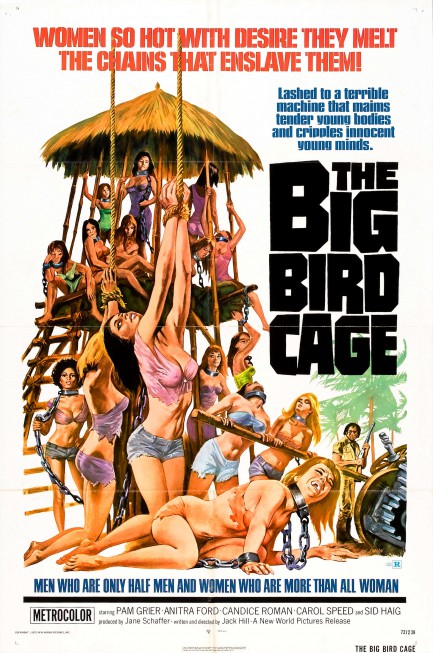
The Big Bird Cage finds writer-director Jack Hill at the top of his form as he sticks star Anitra Ford in a Philippine jungle prison where an evil warden uses the female inmates as slave labor to process sugar. Pam Grier and Sid Haig are revolutionaries who want to recruit women for their cause, so Grier infiltrates the prison and primes the women for a big breakout. This is one of the most remembered of 70s B-romps, a sleazefest filled with iconic scenes such as Ford being suspended by her hair, and seven-foot model Karen McKevic slathering her body with grease and dashing naked through camp. The classic poster is above, a brilliant production photo appears below, and if you’re looking for actual reviews, well, there are about a thousand online. Wild, weird, and oh so incorrect, The Big Bird Cage premiered in the U.S. today in 1972.
 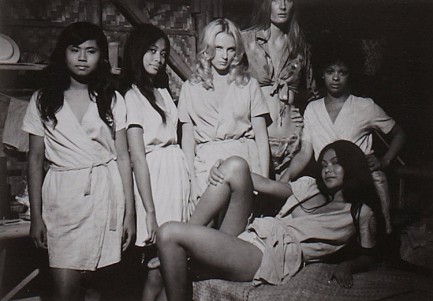 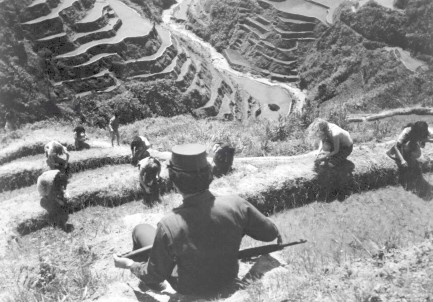 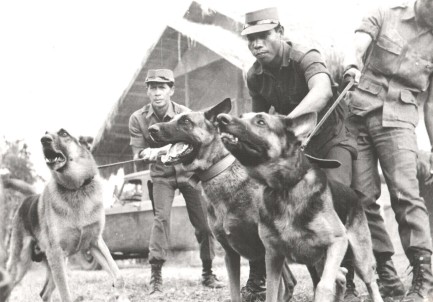 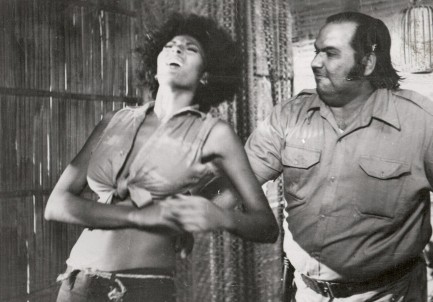 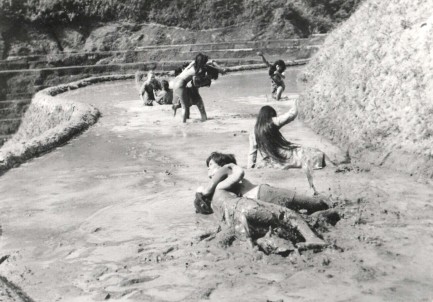 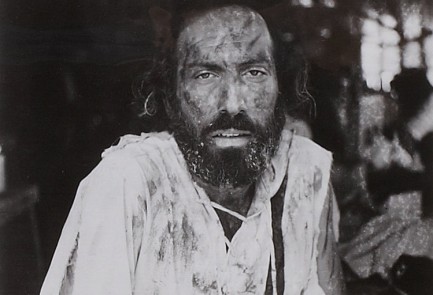 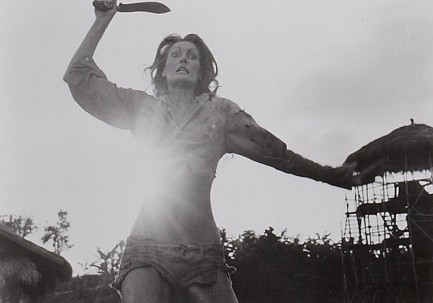 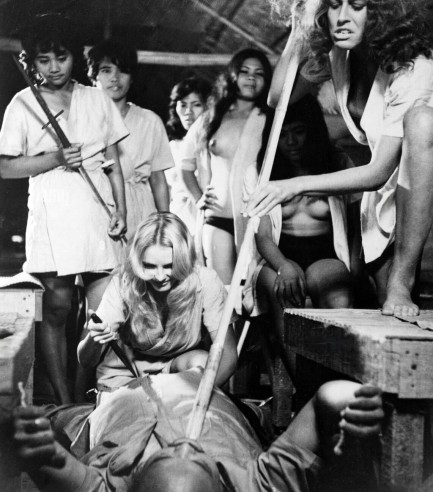 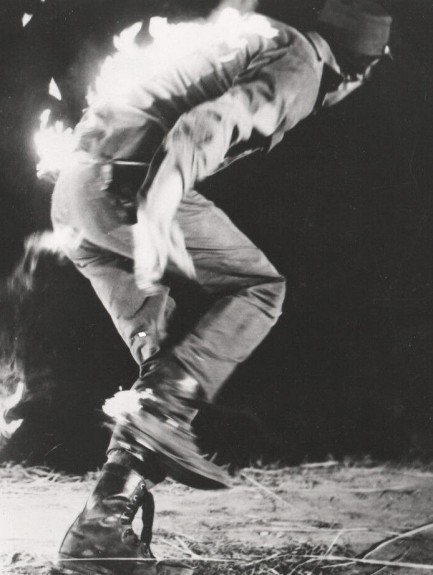 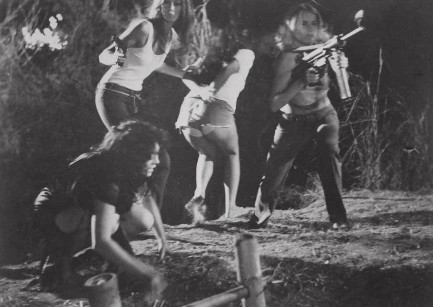 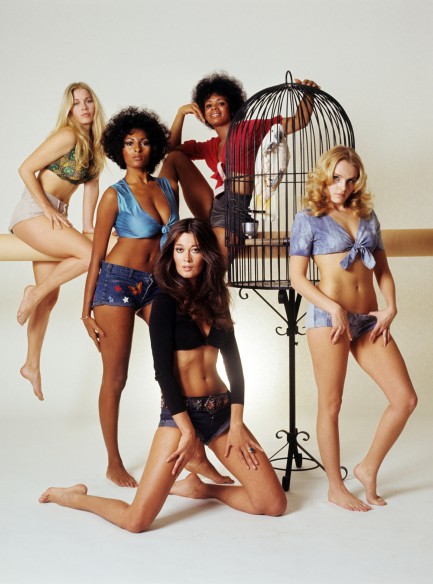
 They might catch her but they can never tame her. 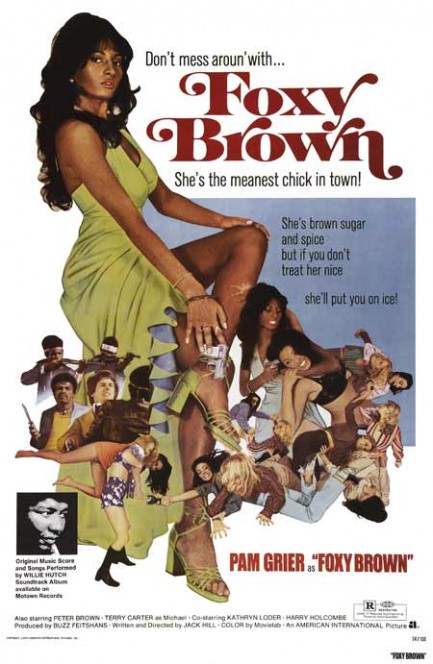 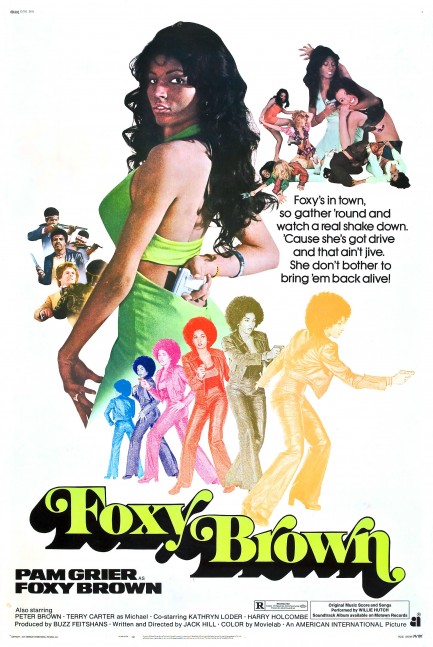
There’s nothing we can write about Pam Grier’s blaxploitation thriller Foxy Brown that hasn't already been written. But our site wouldn’t be complete without an entry on this film, so above are two American promo posters, and below are some production stills. Foxy Brown was made using the same basic blueprint as 1973’s Coffy, and in fact was originally written as a sequel to the earlier film. Why American International ditched the sequel concept and denied itself a franchise is unclear, but the movie was a hit anyway.
We love it, but in honesty, it’s clunkily written and badly acted, however we can also sense how visceral and different it must have felt at the time. At the very least, it’s worth seeing for Grier’s groovy opening dance number. We have some promo photos below, and sharp eyed readers may notice Grier wears the same red cut-out jumpsuit as in Coffy. We haven't mixed up our images. While Grier wears that red jumpsuit in the film Coffy and the promo shots for Foxy Brown, she doesn't actually wear it onscreen in the latter movie. Foxy Brown premiered today in 1974.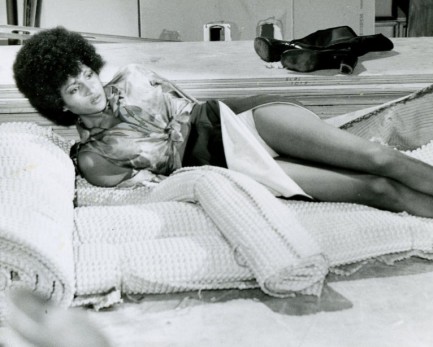 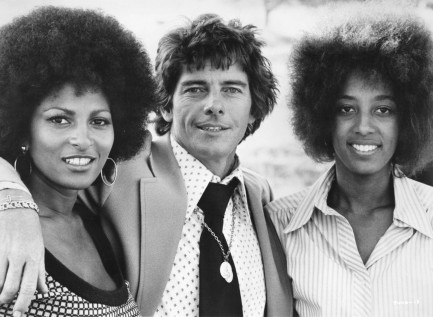 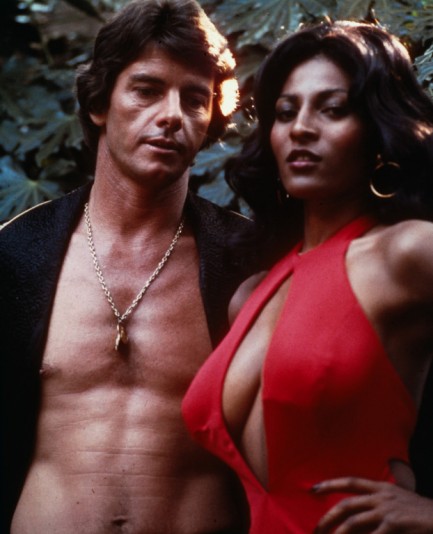 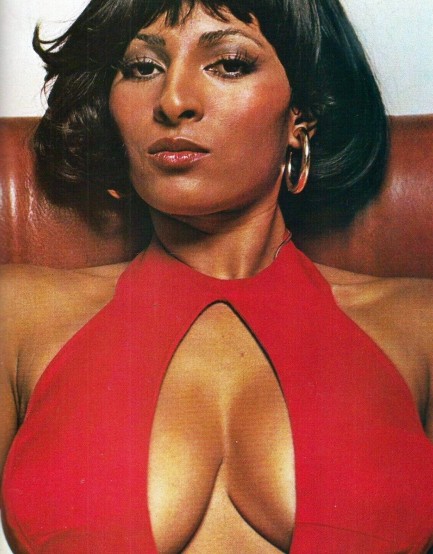 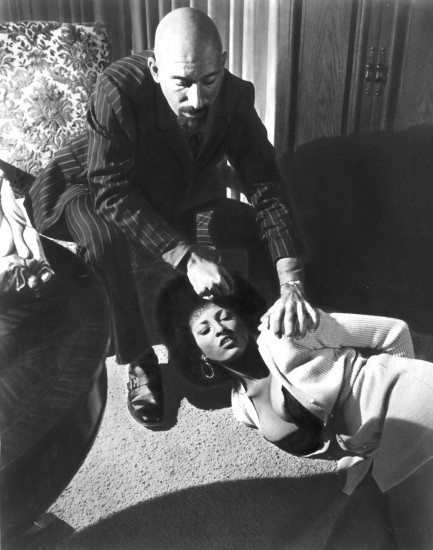 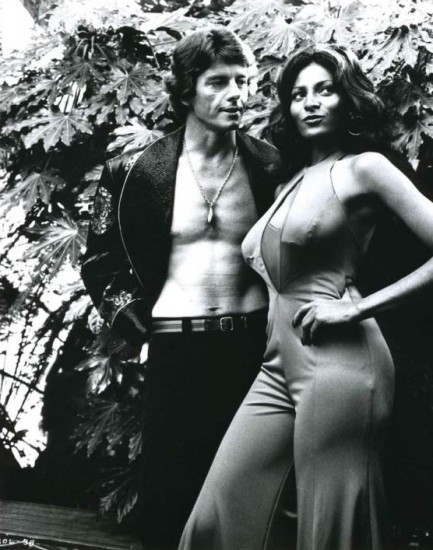 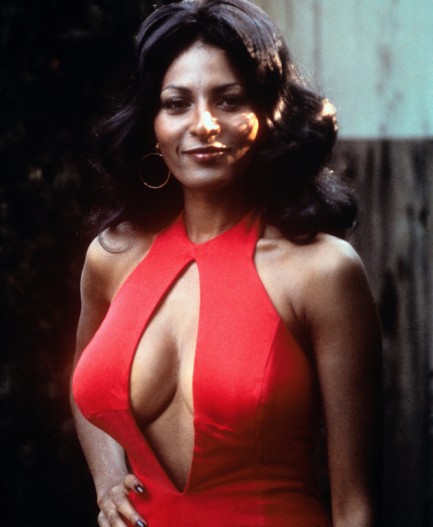 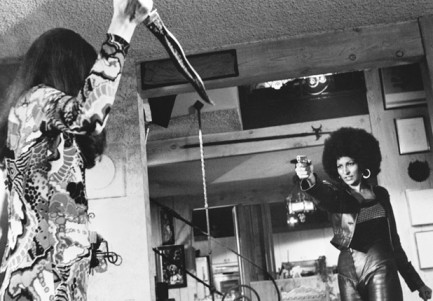 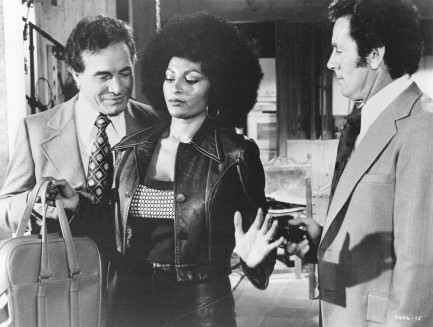 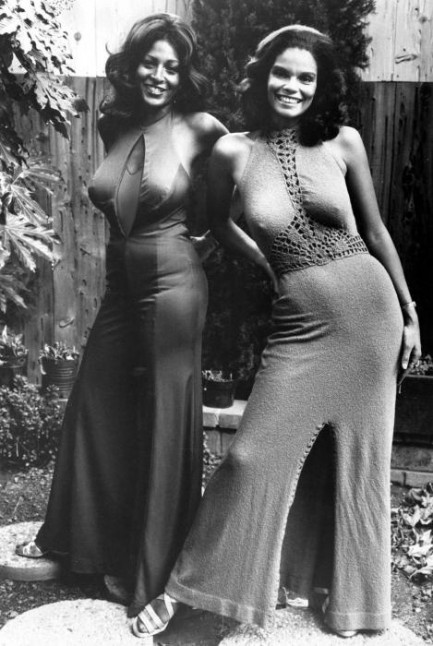 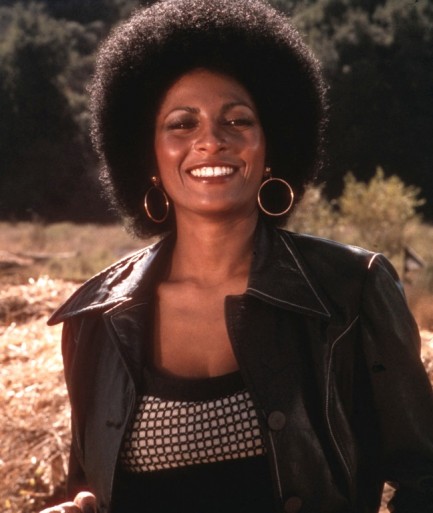
|
 |

The headlines that mattered yesteryear.
2003—Hope Dies
Film legend Bob Hope dies of pneumonia two months after celebrating his 100th birthday. 1945—Churchill Given the Sack
In spite of admiring Winston Churchill as a great wartime leader, Britons elect
Clement Attlee the nation's new prime minister in a sweeping victory for the Labour Party over the Conservatives. 1952—Evita Peron Dies
Eva Duarte de Peron, aka Evita, wife of the president of the Argentine Republic, dies from cancer at age 33. Evita had brought the working classes into a position of political power never witnessed before, but was hated by the nation's powerful military class. She is lain to rest in Milan, Italy in a secret grave under a nun's name, but is eventually returned to Argentina for reburial beside her husband in 1974. 1943—Mussolini Calls It Quits
Italian dictator Benito Mussolini steps down as head of the armed forces and the government. It soon becomes clear that Il Duce did not relinquish power voluntarily, but was forced to resign after former Fascist colleagues turned against him. He is later installed by Germany as leader of the Italian Social Republic in the north of the country, but is killed by partisans in 1945.
|

|
|

It's easy. We have an uploader that makes it a snap. Use it to submit your art, text, header, and subhead. Your post can be funny, serious, or anything in between, as long as it's vintage pulp. You'll get a byline and experience the fleeting pride of free authorship. We'll edit your post for typos, but the rest is up to you. Click here to give us your best shot.

|
|


 I think the crew should have stayed in hibernation.
I think the crew should have stayed in hibernation.















 The “no mercy man” of the lyrics is the protagonist Olie Hand, played by Sandor, which means being raped by the Devil is about the hero. Incredibly, the closing theme is even worse, with the lyrics, “no one understands you ’cause you can't be understood.”
The “no mercy man” of the lyrics is the protagonist Olie Hand, played by Sandor, which means being raped by the Devil is about the hero. Incredibly, the closing theme is even worse, with the lyrics, “no one understands you ’cause you can't be understood.” place vigilante style because of the limits of the law. It was done reluctantly, but creatively, because the capacity for baroque forms of murder lurked beneath the surface all along. American action movies have largely resided in that space ever since: violence is a rarely used but well-oiled tool every real man has at the ready, tucked between his pliers and his socket wrench.
place vigilante style because of the limits of the law. It was done reluctantly, but creatively, because the capacity for baroque forms of murder lurked beneath the surface all along. American action movies have largely resided in that space ever since: violence is a rarely used but well-oiled tool every real man has at the ready, tucked between his pliers and his socket wrench.



































































































































